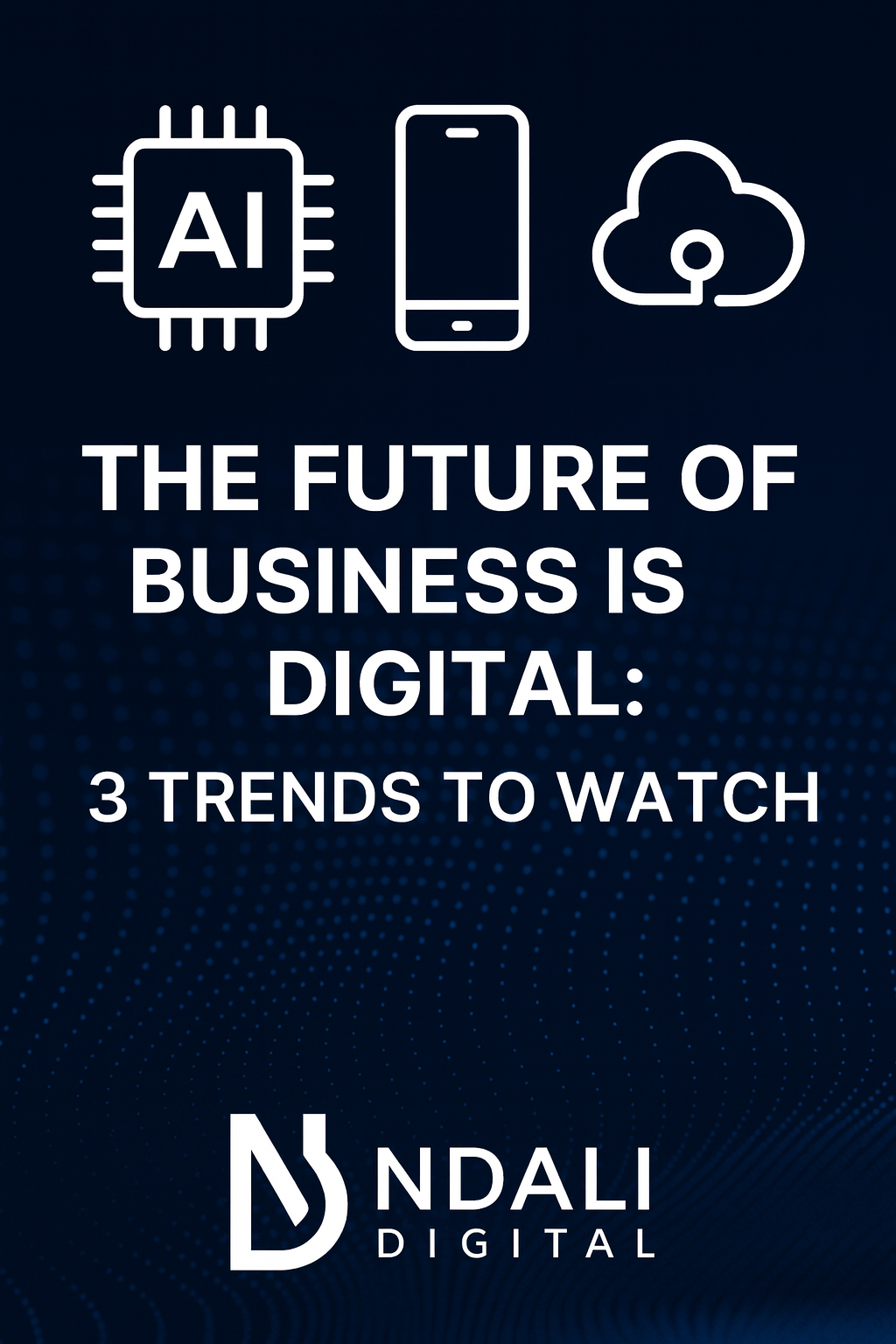Our Blog
Stay up to date with insights, updates, and the latest from our team.

The Power of Automation: Working Smarter, Not Harder
In today’s fast-paced world, automation has become more than just a tech buzzword — it’s the backbone of efficiency, consistency, and scalability. Whether you’re running a small food business, a digital agency, or a full-scale enterprise, automation can transform the way you work. What Is Automation? At its core, automation is the use of technology to perform repetitive tasks with minimal human intervention. It ranges from simple workflows like automatic email responses to advanced systems that integrate artificial intelligence, data analytics, and machine learning to make real-time decisions. Why Automation Matters Saves Time: Tasks that once took hours can now be completed in minutes — freeing up your time to focus on growth, creativity, and innovation. Reduces Errors: Humans make mistakes; automated systems follow consistent rules. Cuts Costs: Fewer manual processes mean lower operational costs in the long run. Improves Scalability: Automation allows businesses to handle growth without increasing workload proportionally. Enhances Customer Experience: Faster response times and reliable service build stronger trust with customers. Real-World Examples Email Automation: Tools like HubSpot or Mailchimp let you send personalized campaigns automatically based on user behaviour. Business Operations: Platforms like Zapier or Make (formerly Integromat) connect apps together so that when one action occurs — say, a form submission — another action, like data entry or notification, happens instantly. Manufacturing & Retail: Robots and IoT devices streamline production lines, track inventory, and even predict maintenance needs. Trading & Finance: Automated bots monitor markets 24/7, identify patterns, and execute trades faster than humans could ever react. How to Get Started Identify Repetitive Tasks: Start by listing tasks you do daily or weekly that don’t require creative thinking. Choose the Right Tools: Use automation platforms compatible with your current systems — e.g., Google Workspace, Slack, or CRM software. Start Small: Automate one or two workflows first; test and refine before scaling. Monitor & Optimise: Automation isn’t “set and forget.” Regularly review performance and make adjustments. The Future Is Automated As technology evolves, automation will only get smarter. Artificial intelligence will personalise customer experiences, predictive analytics will guide business strategy, and interconnected systems will reduce friction between teams, departments, and customers. The question isn’t “Should you automate?” anymore — it’s “What will you automate next?”
2025-10-29

Why Every Business Needs a Strong Digital Presence in 2025
The business world has shifted dramatically over the last decade. Customers no longer stumble upon businesses by chance—they search, scroll, and tap their way to decisions. In this fast-moving digital landscape, your website, app, and brand identity are more than just tools: they are the front door to your business. And just like you wouldn’t ignore the condition of a physical storefront, you can’t afford to neglect your digital presence. In this article, we’ll explore why a strong digital presence is essential in 2025, the key components that make it effective, and how businesses can stay ahead. Your Website Is Your Storefront For many customers, the first interaction with your business happens online. A slow, outdated, or confusing website can be the difference between a new client and a lost opportunity. A modern website should: Load within 3 seconds — studies show that bounce rates skyrocket after this. Be mobile-first — with over 60% of web traffic coming from mobile, desktop-only designs are obsolete. Communicate instantly — your homepage should clearly state what you do, who you serve, and why it matters. Think of your website as the salesperson who works 24/7. If it doesn’t answer questions or inspire confidence, people will move on. Mobile Apps Create Deeper Engagement A website gets people in the door, but an app keeps them engaged. Apps allow businesses to build loyalty programs, send push notifications, and create personalized experiences. Examples include: Restaurants using apps for ordering and exclusive discounts. Retail brands offering personalized recommendations. Service providers scheduling appointments directly in-app. Businesses that invest in mobile apps report increased customer retention and higher lifetime value. Branding Builds Trust Consistency is key. From your logo and colour scheme to your tone of voice, a unified brand presence signals professionalism. Customers trust businesses that look polished and put-together. A strong brand identity helps: Differentiate you from competitors. Create recognition across social media, websites, and advertising. Build long-term trust with clients. Think of companies like Apple or Nike. Their branding isn’t just a logo—it’s a promise of quality. SEO and Content Marketing Drive Visibility Even the best website or app is useless if no one can find it. Search Engine Optimization (SEO) ensures that when potential customers search for services you offer, your business appears. Pairing SEO with content marketing (blogs, case studies, videos) makes you discoverable and builds authority in your niche. Key strategies: Publish blogs that answer customer questions. Optimize for local search if you’re serving a specific region. Use analytics to refine what works and drop what doesn’t. Social Media and Digital Advertising Expand Reach Social platforms like Instagram, TikTok, and LinkedIn are where many customer journeys begin. Combined with paid advertising, they let you reach specific audiences at scale. The beauty is that digital ads provide precise targeting—you’re not throwing money at a billboard and hoping for the best. The Bottom Line: Digital Presence = Growth A strong digital presence isn’t optional—it’s the foundation of modern business. Customers expect it, competitors are already investing in it, and the return on investment is clear. At Ndali Digital, we build digital solutions that help businesses stand out—from apps and websites to branding and beyond. Ready to strengthen your digital presence? [Book a free consultation today] and let’s grow your business.
2025-09-23

From Idea to App Store: How We Build Apps That Users Love
Bringing a mobile app from a simple idea to a live product on the App Store or Google Play is both exciting and challenging. At Ndali Digital, we’ve helped businesses, startups, and entrepreneurs turn concepts into functional, polished apps that users not only download but keep coming back to. In this post, we’ll walk you through our process step by step — so you can see how we transform ideas into apps that people love. Discovery & Strategy Every successful app begins with a clear vision. We start by working closely with our clients to answer key questions: Who is the target audience? What problem does the app solve? What features are “must-have” vs. “nice-to-have”? What are competitors doing (and how can we do it better)? This discovery phase helps us build a strategy that ensures the app aligns with your business goals while meeting user needs. Wireframing & Prototyping Before writing a single line of code, we design the blueprint of your app. Wireframes show the structure and flow, while clickable prototypes allow you to experience the app’s navigation before it’s developed. This stage is crucial because it allows for early feedback, helping us refine the user journey and avoid costly changes later in the process. UI/UX Design A great app isn’t just functional — it’s intuitive and visually engaging. Our design team focuses on: Clean layouts that make navigation effortless. Brand-aligned visuals that reflect your identity. Interactive elements that feel natural on iOS and Android. We also test designs with real users to ensure the experience is smooth and frustration-free. Agile Development With the design in place, our developers get to work. We use an Agile development approach, breaking the project into short sprints. This gives us flexibility to adapt to changes and ensures progress is visible throughout the process. We build apps using modern frameworks and tools, making them scalable, secure, and ready for future updates. Testing & Quality Assurance An app users don’t trust won’t last long on their phone. That’s why we run rigorous testing, including: Functional testing (does every feature work as expected?) Performance testing (is it fast and stable?) Cross-device testing (does it look great on all screens?) We simulate real-world usage, ensuring the app performs reliably under different conditions. Deployment to App Stores Once everything is ready, we prepare the app for release on the App Store and Google Play. This includes handling requirements like metadata, screenshots, icons, and store guidelines — ensuring a smooth approval process. We also set up analytics to track downloads, engagement, and performance from day one. Post-Launch Support & Iteration Launching an app is just the beginning. We monitor feedback, track user behaviour, and provide updates to keep the app fresh. Whether it’s new features, bug fixes, or performance improvements, we ensure your app continues to grow with your users. Why This Process Works By combining strategy, design, development, and continuous improvement, we’ve built apps that are not only functional but truly delight users. The key is always collaboration: we see our clients as partners, working hand in hand to bring their vision to life. ✅ Whether you’re a startup with a big idea or an established business looking to expand into mobile, our team at Ndali Digital is ready to help you create an app that stands out — and earns a permanent spot on your users’ home screens.
2025-09-23

The Future of Business Is Digital: 3 Trends to Watch
The pace of digital transformation has accelerated in ways we couldn’t have imagined just a few years ago. Businesses today are no longer asking if they should go digital — they’re asking how fast they can get there. At Ndali Digital, we help brands embrace technology not just to keep up with the market, but to get ahead of it. From building apps to designing digital experiences, we see every day how quickly the landscape is changing. Here are three major trends shaping the future of business — and why they matter for your company. AI-Powered Personalization Consumers now expect experiences tailored specifically to them. Generic, one-size-fits-all digital strategies are becoming outdated. Instead, businesses are turning to artificial intelligence (AI) to deliver personalization at scale. Think about it: E-commerce platforms are recommending products based on your past purchases. Streaming services suggest shows based on what you’ve watched. Finance apps track spending and offer customized savings tips. For businesses, AI means: Better targeting in marketing campaigns. Improved customer support with AI chatbots. Smarter insights from customer data. 💡 What this means for you: Companies that invest in AI-driven personalization will increase customer loyalty, engagement, and sales. Customers stay longer when they feel seen. The Rise of Mobile-First Experiences It’s no secret that mobile has taken over — but what’s important is how deep that shift really goes. Studies show that more than half of all web traffic now comes from mobile devices, and for many people, their phone is their primary gateway to the internet. This means: Apps and websites must be mobile-first, not desktop-down. Speed, simplicity, and intuitive design are critical. Payments, notifications, and user journeys should be optimized for the small screen. We’ve seen businesses struggle because their platforms weren’t designed for mobile users — leading to high bounce rates and missed opportunities. On the flip side, companies that invest in mobile-first design often see dramatic improvements in conversion and customer retention. 💡 What this means for you: If your digital presence doesn’t put mobile at the center, you’re already behind. Optimizing for mobile is no longer optional — it’s the standard. Cloud and Remote Collaboration The pandemic proved something powerful: businesses can thrive virtually. Cloud-based tools like Slack, Zoom, Notion, and Google Workspace didn’t just help teams survive — they redefined how companies operate. Today, cloud adoption is about much more than remote work. It’s about: Scalability – growing without the limits of local infrastructure. Flexibility – enabling teams to work anytime, anywhere. Security – protecting data with enterprise-grade systems. Companies of all sizes are now relying on cloud ecosystems not only to collaborate but to innovate faster. Whether it’s running a global team or managing customer data, the cloud is the backbone of modern business. 💡 What this means for you: Cloud-driven companies are more agile, more efficient, and better positioned to adapt to disruption. Looking Ahead Digital transformation isn’t slowing down — it’s accelerating. The businesses that win in the future will be those that: Harness AI to deliver personalization. Embrace mobile-first thinking. Build resilient, cloud-enabled infrastructures. At Ndali Digital, we believe every business can harness these trends — not just the big players. Whether it’s an app, a website, or a digital brand refresh, the key is to act now, not later. Because the future of business isn’t coming. It’s already here.
2025-09-23

The Power of User Experience: Why Design Is More Than Looks
When people hear the word design, they often think of visual elements: colors, fonts, and layouts. While aesthetics play a role, true design goes much deeper. It’s about the overall experience—how users feel when interacting with your product, website, or app. At Ndali Digital, we believe great design is great business. In fact, the difference between a thriving digital product and one that fails often comes down to user experience (UX). Let’s explore why UX matters so much and how businesses can use it as a competitive advantage. First Impressions Are Everything Users form opinions almost instantly. Research shows it takes just 50 milliseconds (0.05 seconds) for someone to judge a website. That’s faster than the blink of an eye. If your homepage looks outdated, takes too long to load, or feels cluttered, visitors won’t stick around. They’ll bounce to a competitor who makes life easier. Good UX design ensures your digital presence communicates professionalism, reliability, and trustworthiness from the very first second. ✅ Example: Think about apps like Airbnb or Spotify. Their clean, modern interfaces make you feel welcome right away—and encourage you to keep exploring. Design Shapes Behavior Design isn’t just about beauty—it’s about guiding people to take action. Every button, link, and scroll path should serve a purpose. UX designers think about flows, not just pages. Where should the “Sign Up” button be placed for maximum visibility? How many steps should checkout take before frustration kicks in? Is the navigation intuitive enough for a first-time visitor to find what they want without thinking? A well-designed experience removes friction and makes users feel confident about what to do next. UX Builds (or Destroys) Trust Would you trust a bank with a broken, confusing app? Probably not. In the digital age, design equals credibility. If a site is inconsistent, glitchy, or hard to use, users subconsciously assume the company itself is disorganized. On the other hand, smooth interactions give the impression of professionalism and attention to detail. A seamless design doesn’t just look nice—it makes customers feel secure about doing business with you. Great UX Drives Conversions Many businesses think they have a marketing problem when in reality, they have a design problem. Imagine this: 10,000 people visit your site each month, but only 1% make a purchase. By improving UX—faster checkout, clearer pricing, simpler navigation—you increase conversion to 3%. That’s a 200% increase in sales, without spending an extra penny on advertising. Small UX improvements often lead to big revenue wins. This is why companies like Amazon obsess over details like button size, product recommendations, and one-click checkout. Accessibility Expands Your Audience UX isn’t just about speed and style—it’s about inclusivity. Accessible design ensures people with disabilities can also use your product. Proper color contrast helps users with visual impairments. Screen reader compatibility supports those with vision loss. Clear navigation and keyboard shortcuts make life easier for everyone. Accessibility isn’t just the right thing to do—it also protects your brand legally and opens your doors to a wider audience. UX Is Emotional Beyond functionality, UX taps into emotion. A beautifully designed product feels enjoyable, reassuring, even delightful. Think about the satisfaction of seeing a progress bar hit 100%, or the animation that plays when you “like” a post on social media. These small touches create positive emotions, making users more likely to return. Design isn’t just utility—it’s also about crafting experiences that make people feel good. UX as a Long-Term Investment Many companies treat UX as a one-time cost: hire a designer, redesign the site, move on. But in reality, UX is an ongoing investment. As technology evolves and customer expectations shift, so should your digital experience. Apps that don’t adapt get abandoned. Websites that don’t update look stale within a year. Forward-thinking businesses continuously test, improve, and refine their UX. It’s not a cost—it’s a growth strategy. Final Thought Design is far more than decoration. It’s the silent salesman that convinces users to stay, buy, trust, and return. At Ndali Digital, we see UX as the bridge between your business and your customers. When you invest in design, you’re not just making your site look pretty—you’re creating an experience that people love to use. In today’s digital-first world, that’s the ultimate competitive edge.
2025-09-23

Digital Banners Still Matter: How to Turn Ad Space Into Impact
When was the last time you noticed a digital banner ad? For many, the answer is “not often.” With all the noise online, banners have gained a reputation for being ignored, skipped, or blocked. But here’s the truth: digital banners still matter—when they’re done right. At Ndali Digital, we’ve helped brands transform simple ad space into powerful storytelling tools that drive clicks, conversions, and brand recognition. Let’s break down why banners are still relevant and how to make them work for your business. The Evolution of the Banner Ad The first-ever digital banner ad launched in 1994. It was simple, bold, and got a 44% click-through rate—unheard of today. Fast forward three decades, and the internet is saturated with ads. People see thousands of them daily. But instead of making banners obsolete, this evolution has pushed designers and marketers to be smarter, not louder. Modern banners are dynamic, interactive, and highly targeted. Why Banners Still Work in 2025 Reach where people already are → Banners live on websites, apps, and platforms your audience uses daily. Targeted delivery → Programmatic advertising means your banner can appear only to the people most likely to care. Visual storytelling → A well-designed banner can communicate more in 3 seconds than a paragraph of copy. Consistency → Seeing your brand across multiple sites builds familiarity and trust. Think of banners as the digital billboards of the internet—they create awareness, spark curiosity, and drive people into your funnel. Design Principles That Win Attention Bad banners scream “ignore me.” Great banners blend creativity with clarity. Here’s what makes the difference: ✅ Strong visuals – Use high-quality images, illustrations, or branded graphics. No pixelated stock photos. ✅ Minimal text – Your message should be scannable in 2 seconds. Think: “20% Off. Shop Now.” ✅ Clear call to action (CTA) – Buttons like “Learn More” or “Get Started” drive clicks. ✅ Brand consistency – Stick to your colors, fonts, and style so banners feel like you. ✅ Responsive design – Your banner should look just as good on a 27-inch screen as it does on a mobile feed. At Ndali Digital, we often animate banners with tools like GSAP or HTML5 to make them interactive without being annoying. A subtle fade, slide, or hover effect can boost engagement dramatically. Common Mistakes That Kill Banner Campaigns ❌ Overloading with text – A banner isn’t a blog post. One headline + one CTA is enough. ❌ Ignoring size formats – A 300x250 banner won’t behave the same as a skyscraper (160x600). Each format needs custom design. ❌ No tracking – If you don’t measure clicks, impressions, and conversions, you’re flying blind. ❌ Using the same creative for months – Audiences get “banner blindness.” Refresh your designs regularly. From Banner to Business Results Banners are often seen as “top of funnel”—just for awareness. But in reality, they can drive direct sales, app installs, and lead generation when paired with the right targeting. Imagine this flow: A user sees your banner for a new app. They click and land on a beautifully optimized landing page. They sign up or download within minutes. That’s not just awareness—that’s growth. The Future of Digital Banners The next wave of banners won’t just be static rectangles. We’re moving toward: Dynamic banners that change content based on user behavior. AI-driven personalization where each viewer sees a version tailored to them. Interactive banners that let you swipe, tap, or even shop directly. Brands that embrace these innovations will stand out in the crowded digital space. Final Thought Digital banners aren’t dead—they’re evolving. When built with strategy, creativity, and technology, banners are one of the most cost-effective ways to keep your brand visible, relevant, and clickable. At Ndali Digital, we don’t just design banners—we design digital experiences that convert. From static to interactive, every pixel is crafted to help your brand stand out where it matters most: in front of your audience.
2025-09-23